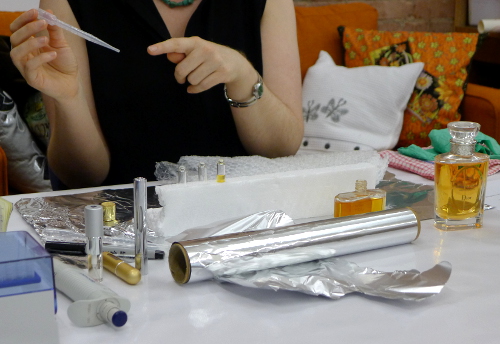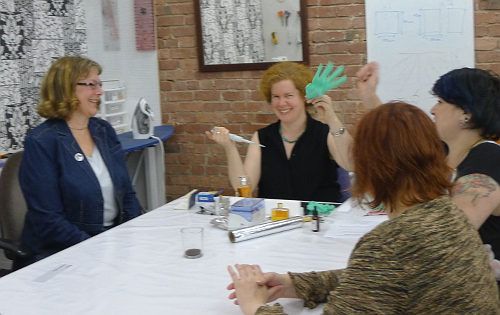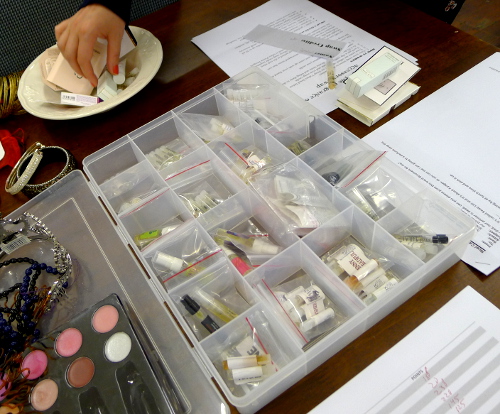The second part of our fragrance day, an accessory and perfume swap, was an intriguing glimpse into how perfumistas and the Internet have changed the cultivated edges of a beauty industry. First, let me announce our giveaway winner, chosen at random – Hester! Thank you everyone!
So what is it like to throw a fragrance and accessory swap? The swap came together naturally, with Made Marion Craft hosting us at their store and a local fragrance appreciator sharing her knowledge of how to sample perfumes. On the swap afternoon, we had a table of necklaces, other jewelry, scarves, gloves,and hats; some shoes; a merry widow; four full-to-1/4-full bottles of fragrance; and about 150 perfume and fragrance oil samples.
150 samples? Whaaaat? Allow me to explain.
These sample vials, ranging from 0.5 to 2 ml of fragrance, are what enable today’s online perfume fans. You can acquire samples and “decants” from most online fragrance vendors and there are two or three places that will send you samples from thousands of fragrance lines – all for a price, of course. But that price is modest compared to buying a full bottle of all those scents ($2 to $6, depending). (Surrender to Chance is the favorite amongst NZ buyers; Black Phoenix Alchemy Lab was one of the originators of this practice.)
These samples are now a kind of currency amongst fragrance fans, and they are swapped or sold on for modest sums. The more rare, artisanal, and complex the sample, the more the perfumistas are intrigued. Once in a while, a sample leads to a full bottle purchase – which is often decanted in part to share with one’s fragrance friends. Fragrance producers large and small, realizing this, have gotten a lot tighter about handing out fragrance samples – I noted this comparing my NYC shopping trips in 2011 and 2013. At the same time this has given a boost to artisanal and unusual fragrance producers – their works are now mailed around the world. Many smaller producers, and I’m using BPAL as an example here again, have bloomed thanks to these samples and related e-commerce.
So we were all rapt for a demonstration of how to decant perfumes into samples ourselves, using a combination of decanting supplies and scientific equipment. Our demonstrator, Alison, took us through three methods: using disposable droppers, using small funnels, and using a scientific pipetting kit. Use recycled styrofoam to hold your sample vials in place, and tinfoil to make an improvised funnel!

The happy miscellaney of sampling fragrances: styrofoam, tinfoil, disposable droppers, travel bottles.
When swap time came, the 150 samples were like a bunch of flowers to some very avid honeybees. The jewelry and even the partial bottles were neglected for the sample box and bowl. During the swap, there wasn’t much perfume in the air – it wasn’t the best time to open the sample vials.
Jewelry started attracting attention again at the end of the swap, and the shy question was: “It’s OK if I take this apart and remake it?” Of course it was! Send it forth to find its destiny! With this answered in the affirmative, the remaining jewelry was swiftly reduced by half.
Was a fragrance swap a good idea? Yes. The biggest challenge in throwing a real-time fragrance swap in a smaller metropolitan area was getting enough perfume aficionados informed, then in the same place, at the same time. A couple of people said they’d be up for an accessory swap but were allergic to fragrances.
What’s up next for fragrance exploration in Wellington? In the springtime, another swap probably, and we are looking at a visit to Fragifert – I look forwards to trying their NZ botanical perfumes.

